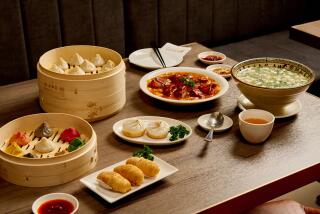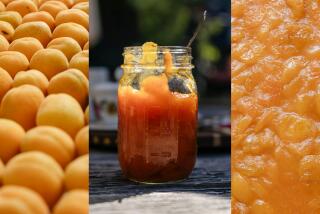Neon Interior : Bright yellow-orange pulp of the passionflower vine’s exotic offspring is sweet-tart and high in Vitamin C.
- Share via
Rather unadorned on the outside, passion fruit appear anything but exotic to the unknowing eye. On the inside, however, an explosion of neon yellow-orange color and a fruity, tropical aroma just wait to be released. One slice of the knife and you’ll realize why this commercially burgeoning fruit is marketed as an exotic.
Unusual? Absolutely. Its roundish, dark purple shell of a skin houses a small mass of brightly hued pulp. Each oblong, juicy morsel contains a tiny dark seed, looking somewhat like an extraterrestrial eyeball. But once you’re convinced that the halved passion fruit isn’t some sort of sci-fi prop, grab a spoon and scoop yourself a mouthful. You’ll discover the pulp to be slightly acidic with an intense and unique sweet-tart flavor.
While passion fruit--rich in Vitamin C--is commonly blended into fruit juice products, its popularity for other fresh uses is on the rise. Enjoyed out of hand for a refreshing snack, the pulp also can be used to top ice cream, embellish a salad, in sauces, stirred into yogurt or mousse, and it has even been used for baking.
Though differing varieties are propagated worldwide, most of the vine-grown fruit bound for the fresh market is grown in New Zealand, Florida and Southern California--including Ventura County. John Wise, proprietor of the Fillmore-based Ladera Fruit Co., has been growing passion fruit for two years in the Moorpark area.
“We’re pioneers out here,” Wise said. “Trying to raise it outside of its (subtropical) habitat can be real difficult.”
Known as a “self-picker,” the large, plum-like fruit is ready for market once it drops from the vine. In about a week to 10 days, the fruit will begin to wrinkle. Though usually purchased when firm and smooth, it’s ready to eat as soon as the wrinkling process begins. To slow this ripening process, Wise suggests refrigerating the fruit until ready for use.
California Tropics in Carpinteria also grows passion fruit--30 acres of it--and since the mid-1980s has become a major provider to the U. S. market. Owner Peter Nichols said the fruit got its name from early missionaries in South America who admired the vine’s colorful flowers. Their chosen moniker was “Passion of Our Lord.”
Nichols said the missionaries envisioned the parts of the flower to symbolize the Crucifixion: The flower’s 10 petals represent the Apostles present, its dark ring was seen as the crown of thorns, five pollen-bearing stamens symbolize Christ’s wounds, and three pollen-catching stigmas represent the loaves of bread broken during the Last Supper.
Biblical history aside, Aztec Indians found practical use for the vines and its fruit, Nichols said. “The Indians used passion fruit for tea and many medicinal purposes, including to treat wounds,” he said. “It was also reputed to be an aphrodisiac.”
Quoting from the “Guide to Medicinal Plants of the United States,” Nichols said the fruit is known to subdue hyperactivity and be helpful in combatting insomnia, nervous tension and other ailments. “I’ve had people tell me they once popped pills to help them fall asleep and now they eat a passion fruit before going to bed.”
Both Wise and Nichols sell some of their passion fruit to World Variety Produce Inc. in Los Angeles, which markets the fruit under the “Melissa’s” brand name. You can purchase passion fruit at upper-scale markets and chains, including Ralphs, Hughes and Vons.
“It’s available pretty much on a year-round basis,” said Jimmy Hernandez, co-owner of World Variety Produce. “It’s really starting to catch on and has become more and more popular in the last few years as customers become more familiar with it.”
Passion fruit for now isn’t cheap. You’re likely to pay upward of $1 or more for a single piece of fruit. Prices, however, should drop substantially in the near future, Nichols said.
“I definitely see prices coming down because of increased production,” he said. By July, Nichols estimates that passion fruit will cost in the neighborhood of three for $1.
Keep in mind while you wait for prices to drop that a little bit of passion fruit goes a long way. When baking chicken, for example, squeeze the juice and seeds of two fruit over the chicken for a tangy embellishment.
“It also works perfect for fish,” Nichols said. “The flavor is just incredible and all the better once you start cooking with it.”
SERVING SUGGESTION / FROZEN YOGURT
1 1/2 cups plain yogurt
1/2 cup sugar
pulp of three passion fruit
1 teaspoon vanilla
2 egg whites
Combine yogurt, sugar, passion fruit pulp and vanilla. Pour into ice cube tray and freeze until mushy. Chill mixer bowl. In it, beat egg whites until frothy. Add yogurt mixture and beat until smooth and light. Freeze until firm. Serve somewhat softened. Makes 4 to 6 servings.
More to Read
Eat your way across L.A.
Get our weekly Tasting Notes newsletter for reviews, news and more.
You may occasionally receive promotional content from the Los Angeles Times.










